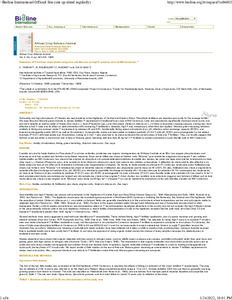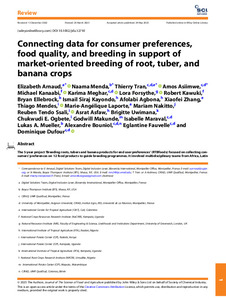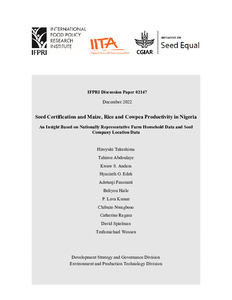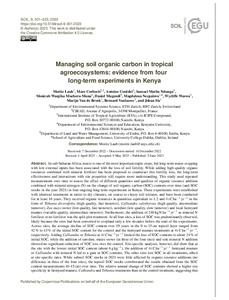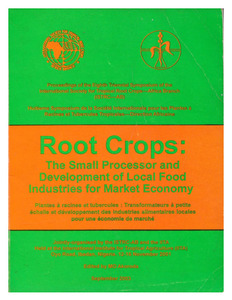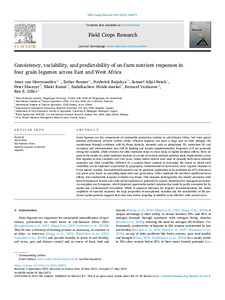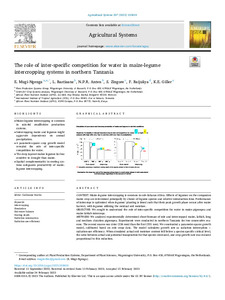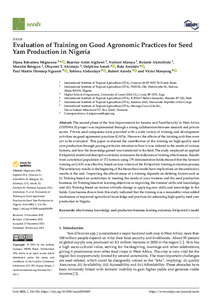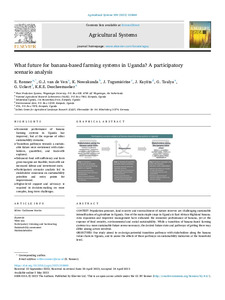Welcome to the International Institute of Tropical Agriculture Research Repository
IITA Bibliography System: Recent submissions
Now showing items 441-460 of 8094
-
Reduction of P fertilizer requirement using lime and Mucuna on high P-sorption soils of NW Cameroon.
(1996)Soil acidity and high phosphorus (P) fixation are real problems in the Highlands of Central and Eastern Africa. Phosphatic fertilizers are imported and costly for the average farmer. We used lime and Mucuna green manure to reduce fertilizer P requirement of traditional food crops in NW Camcroon. Lime and phosphorus significantly improved stand count, root and stem weights as well as yields of maize (Zea mays L.), bean (Phaseolus spp.), and Irish potato (Solanum tuberosum L.) in three consecutive ... -
Fertility characterization of soils at six research sites in NW Cameroon
(1995-01)Fertility capability of surface (0–20 cm) soils was evaluated at six sites in the North-West Cameroon highlands. Two main soil groups, designated as Classes A and B, were identified based on elevation. The Class A soils from low elevations (600–1178 m) had higher Ca, Mg, K, pH, sorbed less P and were lower in organic carbon and sesquioxides than the highland (> 1200 m) soils. Soil acidity (Al saturation > 30%) and high P sorption appeared to be the most limiting factors to crop production especially ... -
Connecting data for consumer preferences, food quality, and breeding in support of market-oriented breeding of root, tuber, and banana crops
(2023)The 5-year project ‘Breeding roots, tubers and banana products for end user preferences’ (RTBfoods) focused on collecting consumers' preferences on 12 food products to guide breeding programmes. It involved multidisciplinary teams from Africa, Latin America, and Europe. Diverse data types were generated on preferred qualities of users (farmers, family and entrepreneurial processors, traders or retailers, and consumers). Country-based target product profiles were produced with a comprehensive market ... -
Implication of blanket NPK application on nutrient balance of maize based on soil and tissue diagnosis approaches in the savannas of northern Nigeria
(2023)Improper nutrient management reduces the yield and affects the nutrient status of crops. This study aimed to diagnose the nutrients limitation in maize. A three-year multi-location (348 sites) nutrient experiments were conducted in randomized block design to analyse nutrients limitation for maize production under conventional fertilizer recommendation system in Nigeria using DRIS, and to identify soil factors that influence DRIS indices using random forest model. DRIS indices for nutrients were ... -
Do soil and water conservation practices influence crop productivity and household welfare? Evidence from rural Nigeria
(2023-04)One of the most serious challenges threatening agricultural sustainability in Nigeria is land degradation. Although this issue has received little attention, soil and water conservation practices have been identified as a possible pathway out of the potential problems posed by land degradation. Therefore, the central research question that this paper tries to address is the following: Do adoption of soil and water conservation (SWC) practices affect crop productivity and household welfare? This ... -
Prediction of functional characteristics of gari (cassava flakes) using near-infrared reflectance spectrometry
(2023-05-10)Gari is a creamy, granular flour obtained from roasting fermented cassava mash. Its preparation involves several unit operations, including fermentation, which is essential in gari production. Fermentation brings about specific biochemical changes in cassava starch due to the actions of lactic acid bacteria. Consequently, it gives rise to organic acids and a significant reduction in the pH. Consumer preferences for gari are influenced by these changes and impact specific functional characteristics, ... -
Elite cassava clones (Manihot esculenta) grown in Zambia: effects of drying techniques on their chemical, functional, and pasting properties.
(2023)Introduction: Cassava (Manihot esculanta) is becoming an important crop in most developing countries, especially Zambia. However, cassava roots deteriorate quickly after harvest, producing flour or chips of sub-optimal quality. Hence the evaluation of processing procedures to extend the product’s shelf-life cannot be overemphasized. This study investigated the effects of different drying methods on the chemical, functional and pasting properties of selected advanced cassava clones grown in Zambia. ... -
Genetic mapping, candidate gene identification and marker validation for host plant resistance to the race 4 of Fusarium oxysporum f. sp. cubense using Musa acuminata ssp. malaccensis
(2023-06)Fusarium wilt of banana is a devastating disease that has decimated banana production worldwide. Host resistance to Fusarium oxysporum f. sp. Cubense (Foc), the causal agent of this disease, is genetically dissected in this study using two Musa acuminata ssp. Malaccensis segregating populations, segregating for Foc Tropical (TR4) and Subtropical (STR4) race 4 resistance. Marker loci and trait association using 11 SNP-based PCR markers allowed the candidate region to be delimited to a 12.9 cM genetic ... -
Seed certification and maize, rice and cowpea productivity in Nigeria: an insight based on nationally representative farm household data and seed company location data
(International Food Policy Research Institute, 2022-12)Despite the potential importance of seed quality to agricultural productivity growth, many governments in sub-Saharan Africa lack the capacity to expand quality assurance systems even where there is expressed interest. This study aims to evidence the value of quality assurance systems with an analysis of efforts to produce and distribute certified seed in Nigeria. We assess the associations between quantities of certified seeds produced and spatial variations in production locations proxied by ... -
A report of meloidogyne arenaria parasitizing plantain (Musa spp., AAB) in Nigeria
(2023-06-06)Extensive root galling observed on plantain (Musa spp., AAB) in Nigeria was analysed using Nad5 mitochondrial DNA sequences and the causal agent identified as Meloidogyne arenaria. Following the inoculation of population cultured, Koch’s postulates was fulfilled and the same symptoms observed. This provides the first molecular confirmation of M. arenaria causing such damage to plantain and highlighting its potential as a threat to the crop. Root knot nematodes are known to affect banana and plantain ... -
Managing soil organic carbon in tropical agroecosystems: evidence from four long-term experiments in Kenya
(2023-06-05)In sub-Saharan Africa, maize is one of the most important staple crops, but long-term maize cropping with low external inputs has been associated with the loss of soil fertility. While adding high-quality organic resources combined with mineral fertilizer has been proposed to counteract this fertility loss, the long-term effectiveness and interactions with site properties still require more understanding. This study used repeated measurements over time to assess the effect of different quantities ... -
Increased mineral fertilizer use on maize can improve both household food security and regional food production in East Africa
(2023-02)CONTEXT Despite recent improvements in living standards, a substantial proportion of farm households in sub-Saharan Africa (SSA) is food insecure, and increasing crop productivity could help address this problem. OBJECTIVE We estimated the effect of increasing maize yields with mineral fertilizer on household food security and on regional and national maize supply in two East African countries - Uganda and Tanzania. METHODS We estimated maize yield response to nitrogen (N) fertilization ... -
Varietal characteristics of cassava: farmers' perceptions and preferences in semiarid zone of west Africa
(IInternational Institute of Tropical Agriculture, 2003-09)The study examines and models Farmers' perceptions and preferences of cassava· varietal characteristics vis-i-vis the decision ' to adopt cassava cultivars in their fields. The paper is built on the concept of the effect of technology-specific factors on adoption. By way of threshold decision modelling for each of the countries considered, the results reveal different scenario. Based on the varietal characteristics considered, environmental resistance quality (ERQ), high-yielding quality (HYQ), ... -
Maturity class and P effects on soya bean grain yield in the moist Savanna of west Africa
(2003-12)Field trials were replicated at four sites in the moist savanna ecological zone of West Africa to study the effect of maturity class and phosphorus (P) rate on grain yield and total protein yield (TPY) of some new soya bean varieties. Grain yield and TPY averaged 1.43 Mg ha−1 and 587 kg ha−1, respectively. Without P application grain yield and TPY were not significantly different among the varieties. In addition, at zero P treatment, grain yield and TPY were not significantly different among three ... -
Consistency, variability, and predictability of on-farm nutrient responses in four grain legumes across east and west Africa
(2023-08)Grain legumes are key components of sustainable production systems in sub-Saharan Africa, but wide-spread nutrient deficiencies severely restrict yields. Whereas legumes can meet a large part of their nitrogen (N) requirement through symbiosis with N2-fixing bacteria, elements such as phosphorus (P), potassium (K) and secondary and micronutrients may still be limiting and require supplementation. Responses to P are generally strong but variable, while evidence for other nutrients tends to show ... -
The role of inter-specific competition for water in maize-legume intercropping systems in northern Tanzania
(2023-04)CONTEXT Maize-legume intercropping is common in sub-Saharan Africa. Effects of legumes on the companion maize crop are determined principally by choice of legume species and relative introduction time. Performance of intercrops is optimized when legumes' planting is timed such that their peak growth phase occurs after maize harvest, with legumes utilizing the residual soil moisture. OBJECTIVE We sought to understand the role of inter-specific competition for water in maize-pigeonpea and maize-lablab ... -
Soil mineralogical and nutrient characteristics of forest islands and surrounding ecosystem types in West Africa suggest anthropogenic soil improvement
(2023-05-12)Aims Ecosystem changes in the mesic savannas of West Africa are resulting in the formation of patches of ‘forest islands’ around local communities in an otherwise open savanna landscape. There have been conflicting reports on the origin of these forest islands with a very limited understanding of their biogeochemistry. This study evaluated the soil mineralogical and chemical characteristics of forest islands and their surrounding ecosystems comprising croplands and open savannas in Burkina Faso, ... -
Evaluation of training on good agronomic practices for seed yam production in Nigeria
(2023-02-28)The second phase of the Yam Improvement for Income and Food Security in West Africa (YIIFSWA II) project was implemented through a strong collaboration between research and private sector. Private seed companies were provided with a wide variety of training and development activities on good agronomic practices (GAPs). However, the effects of the training activities were yet to be evaluated. This paper evaluated the contribution of the training on high-quality seed yam production through paying ... -
What future for banana-based farming systems in Uganda? A participatory scenario analysis
(2023-06)CONTEXT: Population pressure, land scarcity and encroachment of nature reserves are challenging sustainable intensification of agriculture in Uganda. One of the main staple crops in Uganda is East African Highland banana. Area expansion and improved management have enhanced the economic performance of banana, yet at the expense of food security, environmental and social sustainability. While a transition of banana-based farming systems to a more sustainable future seems necessary, the desired ...

